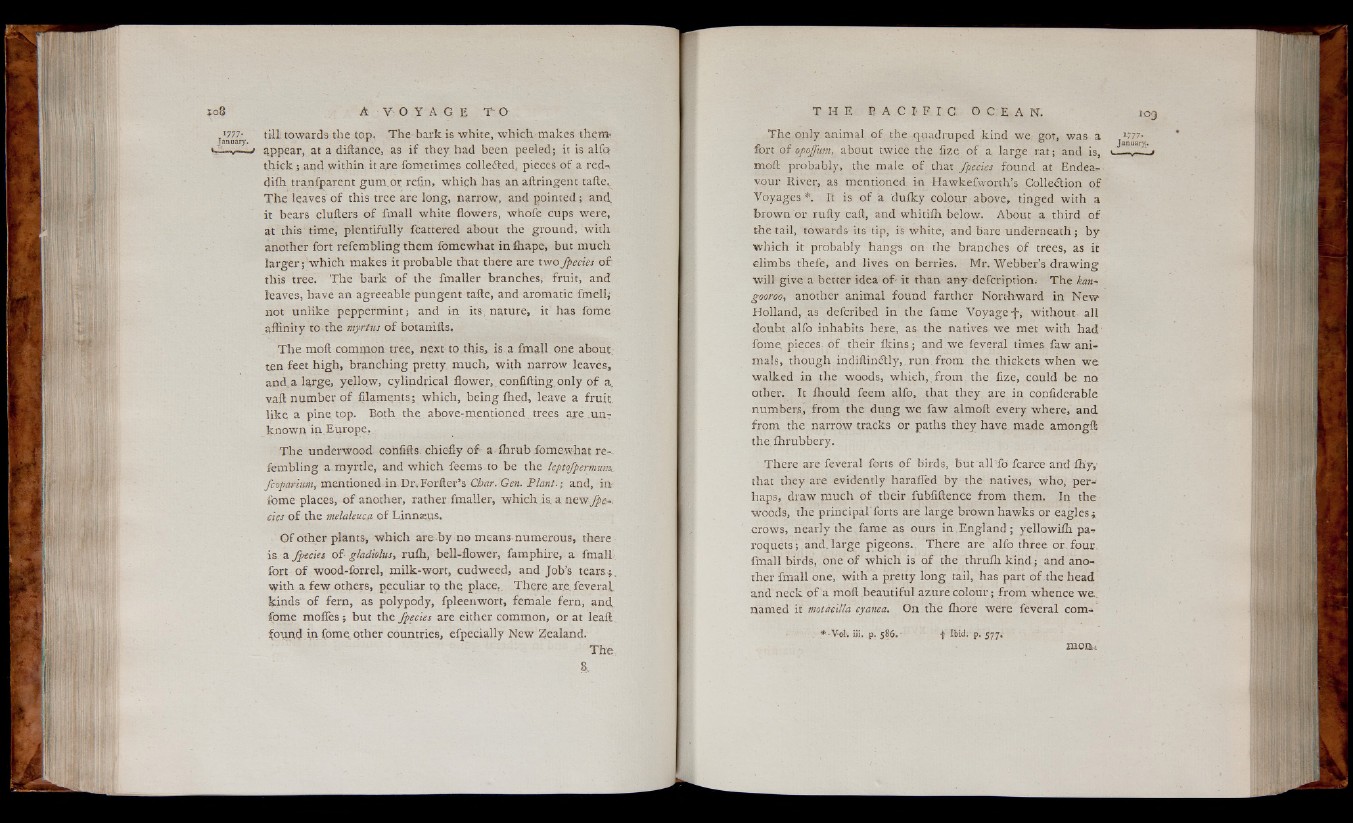
till, towards the top. The bark is white, which makes them?
appear, at a diilance, as if they had been peeled; it is alfct
thick; and within it are fometimes colleited, pieces of a red-,
difh tranfparent gum,or refin, whiqh has an aftringent tafte^
The leaves of this tree are long, narrow, and pointed; and.
it bears clufters of fmall white flowers, whofe cups were,
at this time, plentifully fcattered about the ground, with
another fort refembling them fomewhat in fhape, but much
larger; which makes it probable that there are two fpecies o f
this tree. The bark of the fmaller branches, fruit, and
leaves, have an agreeable pungent tafte, and aromatic fmell;
not unlike peppermint; and in its. nature, i f has fome
affinity to.the my-rtus of botanifts.
The moil common tree, next to this» is a fmall one about,
ten feet high, branching pretty much, with narrow leaves,
and,a large? yellow, cylindrical flower,.confining only of a.
vail number of filaments; which, being ihed, leave a fruit,
like a pine. top. Both the above-mentioned trees are unknown
in. Europe,.
The underwood cohfifts. chiefly of- a fhrub .fomewhat refembling
a myrtle, and which feems to be the leptofpermunu.
fcoparium, mentioned in Dr.Forfter’s Char. Gen. Plant.; and, in
fome places, of another, rather fmaller, which, is. a n ew ^ - .
cies of the melaleuca of Ljnnseus.
Of other plants-, which are by no means- numerous, there
is a fpecies o f gladiolus, ruih, bell-flower, famphire, a fmall
fort of wood-iorrel, milk-wort, cudweed, and Job’s tears;,
with a few others, peculiar to the place,. There are. feveral,
kinds of fern, as polypody, fpleenwort, female fern, and.
fome mofles; but the fpecies are either common, or at leail
found in fome. Other countries, efpecially New Zealand.
The only animal of the quadruped kind we got, was a
fort of opojfnm, about twice the fize of a large rat; and is,
moil probably, the male of that fpecies found at Endeavour
River, as mentioned, in Hawkefworth’s Collection of
Voyages *. It is of a duik.y colour aboye, tinged with a
brown or rufty call, and whitiih below. About a third of
the tail, towards its tip, is white, and bare underneath ; by
which it probably hangs on the branches of trees, as it
climbs thefe, and lives on berries. Mr. Webber’s drawing
will give a better idea of- it than any defcription. The kan*
g o o r o o another animal found farther Northward in New
Holland, as defcribed in the fame Voyage-j-, without all
doubt alfo inhabits here, as the natives we met with had
fome. pieces o f their ikins; and we feveral times faw animals,
though indiitindlly,. run. from the. thickets when we
walked in the woods, which, from the fize, could be not
other. It ihould feem alfo, that they are in confiderable
numbers, from the dung we faw almoil every where, and
from the narrow tracks or paths they have made amongit
the. ihrubbery.
There are feveral forts o f birds, but alTfo fcarce and Qiy,
that they are evidently harafled by the natives; who, perhaps,
draw much of their fubfiftence from them. In the
woods, the principal forts are large brown hawks or eagles;
crows, nearly the fame as ours in England; yellowifli pa?
roquets; and.large pigeons.. There are alfo three or four
fmall birds, one of which is of the thruih kind; and another
fmall one, with a pretty long tail, has part of the head
and neck of a moil beautiful azure colour ; from whence we.
named it motdeilla cyanea. On the ihore were feveral com*
-Vok ili. p . f Ibid. p . 577*